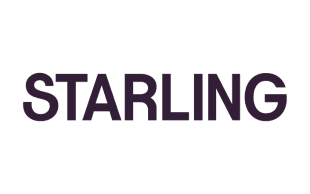Starling vs Monese: Vital statistics
Starling’s free (and only) current account comes with a vertical teal-coloured card, while Monese’s free current account comes with a vertical white card featuring a blue logo.
Neither bank has branches, but you can withdraw or deposit money into your Starling account at Post Office counters, for free. You can also deposit money into your Monese account at Post Office branches or PayPoints, although there is a 3.5% fee (with a minimum charge of £3) for doing this.
Starling lets apply for an overdraft, while Monese doesn’t. Neither pay interest on current account balances.
Starling has a UK banking licence, which means individual customer funds up to the value of £120,000 are protected by the Financial Services Compensation Scheme (FSCS) if the bank were to cease to operate. Monese is not a bank, so is not covered by the FSCS. It is however registered with the FCA as an electronic money institution, which means customer funds must be kept in a separate account at a licensed UK bank, so the money is ring-fenced should the company go under.
In Finder’s 2025 Banking Customer Satisfaction Awards, Starling scored 4.4 out of 5 in our customer survey, with 93% of its current account customers saying they would recommend the brand to a friend. Meanwhile, Monese scored 3.7 out of 5, with 67% of its customers saying they would recommend one of its current accounts.
Round 1: App features
There’s a wide range of near-identical money management and banking features in the Starling and Monese mobile apps. Both have spending categories, where your transactions are automatically placed into pre-set categories like transport or groceries (Starling has 53 of these categories, while Monese has 15). This in turn generates weekly or monthly spending insights, which helps you set budgets, plus the apps alert you when payments leave your account.
Starling has “Goals” and Monese has “Pots” where you can set funds aside for specific treats or savings targets, like a dream holiday or a deposit for a car. Both also offer “round-ups”, where spare change from your transactions can be “rounded up” and put into your savings bucket.
You can pay your salary into either your Starling or Monese account, manage direct debits and make international payments. You can freeze or unfreeze your card in the apps, as well as contact both customer service teams through the in-app chats. With Starling you can also speak to a customer service agent over the phone, although the same is not true for Monese.
You can also use Starling’s cheque scanning tool to pay cheques into your account should you need to, whereas Monese doesn’t accept cheques at all.
Winner: Starling – just. The apps offer a broad range of very similar features, but you can’t reach Monese on the phone or deposit cheques into its account.
Round 2: Spending in the UK
You can use either your Starling or Monese card to spend for free in the UK, plus both cards can be used for contactless transactions up to the standard limit.
Both cards are also compatible with Apple Pay and Google Pay, should you want to use either of those to make a payment with your mobile phone. Starling also supports the Samsung Pay mobile wallet, but Monese doesn’t.
There’s no limit to how much of your money you can withdraw for free at UK ATMs with a Starling card, while Monese charges 2% per withdrawal.
Winner: Starling, for its unlimited free ATM withdrawals (and its compatibility with Samsung Pay, if that’s the mobile payment service you use).
Round 3: Using the card abroad
There’s no charge to make a purchase or take money out of an ATM abroad – wherever you are in the world – if you have a Starling card.
With Monese, however, you’ll be charged 2% for all foreign transactions, as well as a £1.50 fee for cash withdrawals overseas.
Winner: Starling, for its unlimited free spending and ATM withdrawals abroad.
Round 4: Account types
 |  | |
| Free account | ||
| Premium account | ||
| Joint account | ||
| Teen account (for 16- and 17-year olds) | ||
| Kids' account or card | ||
| Business account | ||
| Find out more |
Starling and Monese both offer free current accounts. For Starling, it’s the only personal current account it operates, but Monese has expanded its current account range with 2 paid-for tiers – Classic and Premium.
Starling offers joint accounts and business accounts, as well as a kids’ card called Starling Kite, and a teen account for 16- and 17-year-olds.
Monese also offers joint accounts and business accounts, but it doesn’t operate teen or child accounts.
Winner: Tie. Out of the pair, only Starling offers a kids’ card and teen account, but only Monese offers premium account options.
Round 5: Signing up
 |  | |
| Apply through the app | ||
| Quick application | ||
| Credit check | ||
| Card delivery fee | Free | £4.95 |
| Card delivery timescale | 3-5 working days | 3-5 business days |
| Find out more |
You can apply for either a Starling or Monese account through their respective mobile apps in a matter of minutes. There are no credit checks, although a photo of your ID and a short selfie video is required.
The accounts are then usually opened on the same day and both the cards are sent through the post, taking the same amount of time to arrive. However, while the Starling card is sent out to you for free, Monese charges £4.95 for card delivery.
Winner: Starling, for its free card delivery – although both accounts are quick and easy to set up.
Round 6: Customer reviews
On reviews site Trustpilot, Starling has a score of 4.2 from more than 43,000 reviews. Monese has a score of 4.2 out of 5 from almost 46,000 reviews. These were checked in March 2025.
Starling customers said the app was easy to use, but there were some complaints about technical problems.
Reviews about Monese said it works smoothly, though some people had issues with customer service.
In Finder’s 2025 Banking Customer Satisfaction Awards, Starling scored 4.4 out of 5, with 93% of its current account customers saying they would recommend it. Monese scored 3.7 out of 5, with 67% of its customers saying they would recommend one of its accounts.
Winner: Starling, because of its higher scores in both measures.
Overall verdict: Is Starling better than Monese?
Starling won every category in this guide apart from 1, which was a tie. It is just better in a lot of areas, particularly for its fee-free spending and ATM withdrawals at home and abroad.
The areas where Monese slightly trailed in our comparison may not have an impact on your own particular banking needs, especially if you don’t need cheques and or a teen account or kids’ card. But overall it’s just not as good as Starling.
Sources
More guides on Finder
-
Monzo Max review: Is the account worth it?
Is the Monzo Max account worth applying for?
-
Is Monzo Perks worth it?
Are Monzo Perks, Monzo Max and Monzo Extra worth the money? See our analysis in this video review.
-
Best online-only banks in the UK
Online-only banks have some limitations, but they also tend to offer handy features that might convince you to switch.
-
How to withdraw cash from an ATM without your debit card
If you’ve forgotten or misplaced your bank card and need to take out cash, several options are available. From where to get cashback to what you need to take to a branch, here’s what you need to know.
-
How to get a prepaid debit card without ID
Prepaid cards are a good option for people who don’t have any traditional forms of ID. Discover what you could use instead.
-
BuildMyCreditScore review
Discover more about how BuildMyCreditScore works, which banks it connects to and how long it will take to improve your credit score.
-
Banks that allow you to pay cheques in online
Discover which banks let you pay in cheques online and how to do it.
-
Advantages and disadvantages of an overdraft
Find out more about the pros and cons of an overdraft.
-
Santander Edge Up review
Level up your cashback earning potential with the Santander Edge Up current account. Find out about its features and benefits in our review.
-
Monzo bank account and card review
Is Monzo’s app-only current account the right option for you? Read our review to get the low-down on all of the features of the account, its card and the app.



